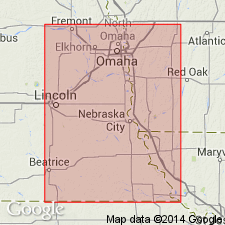
- Usage in publication:
-
- Happy Hollow limestone
- Modifications:
-
- Original reference
- Dominant lithology:
-
- Limestone
- AAPG geologic province:
-
- Forest City basin
Summary:
Pg. 40, 58. Happy Hollow limestone in White Cloud shale bed of Scranton shale member of Shawnee formation. [See entry under White Cloud.]
Source: US geologic names lexicon (USGS Bull. 896, p. 907); GNC KS-NE Pennsylvanian Corr. Chart, sheet 1, Oct. 1936; supplemental information from GNU records (USGS DDS-6; Denver GNULEX).
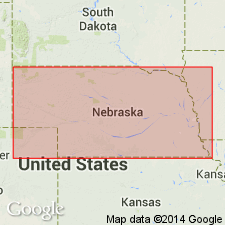
- Usage in publication:
-
- Happy Hollow limestone bed
- Modifications:
-
- Contact revised
- AAPG geologic province:
-
- Nemaha anticline
Summary:
Pg. 53. Happy Hollow limestone bed of Scranton shale member of Shawnee group. Restricted White Cloud shale to beds below Happy Hollow limestone, named the shale overlying Happy Hollow limestone Cedar Vale shale, and stated that Happy Hollow limestone persists from Nebraska to Oklahoma with several feet of shale between it and Rulo limestone. Age is Pennsylvanian.
Source: US geologic names lexicon (USGS Bull. 896, p. 907); GNC KS-NE Pennsylvanian Corr. Chart, sheet 1, Oct. 1936; supplemental information from GNU records (USGS DDS-6; Denver GNULEX).
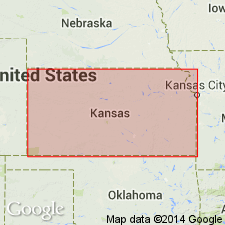
- Usage in publication:
-
- Happy Hollow limestone
- Modifications:
-
- Principal reference
- Revised
- AAPG geologic province:
-
- Forest City basin
Summary:
Pg. 49 (fig. 11), 211-212. Happy Hollow limestone of Wabaunsee group. Traceable from Cass County, across Kansas, and at least to southern part of Osage County, Oklahoma. Thickness 1 to 8 feet. Overlies White Cloud shale and underlies Cedar Vale shale. Typically it is in a single massive bed of pinkish-brown, somewhat impure limestone that weathers in rounded or irregularly porous surfaces; in places very sandy and locally soft and shaly. Age is Late Pennsylvanian (Missouri age). [Moore discarded Scranton shale and treated Happy Hollow limestone as a formation in his redefined Wabaunsee group.]
[GNC remark (ca. 1960, US geologic names lexicon, USGS Bull. 1200, p. 1669): Type locality in vicinity of Happy Hollow ravine, below mouth of Big Nemaha River, southeast of Rulo, Richardson Co., NE. Moore (1936) gave type locality as Happy Hollow Creek, northeastern Doniphan Co., eastern KS.]
Source: US geologic names lexicons (USGS Bull. 896, p. 907; USGS Bull. 1200, p. 1668-1669); GNC KS-NE Pennsylvanian Corr. Chart, sheet 1, Oct. 1936.
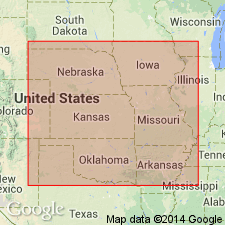
- Usage in publication:
-
- Happy Hollow limestone member*
- Modifications:
-
- Revised
Summary:
Pg. 2274 (fig. 1), 2277. Happy Hollow limestone member of Scranton shale. Rank reduced to member of Scranton shale here reintroduced a formation with stratigraphic span as assigned to it by Haworth and Bennett (1908). Overlies White Cloud shale member; underlies Cedar Vale shale member. Age is Late Pennsylvanian (Virgilian).
Source: US geologic names lexicon (USGS Bull. 1200, p. 1668-1669).
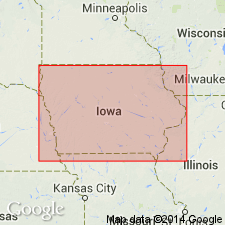
- Usage in publication:
-
- Happy Hollow limestone
- Modifications:
-
- Areal extent
- AAPG geologic province:
-
- Forest City basin
Summary:
Pg. 10. Happy Hollow limestone of Wabaunsee group. Formation in Wabaunsee group. Poorly exposed in Iowa. In limited exposure, in SE/4 NE/4 sec. 19, T. 73 N., R. 35 W., Adams County, a fine-grained, sandy limestone that weathers yellowish is tentatively identified as Happy Hollow limestone. In drillhole near Coin, unit is about 2 feet thick. Underlies Cedar Vale shale; overlies White Cloud shale. [Age is Late Pennsylvanian (Virgil).]
Source: Publication; US geologic names lexicon (USGS Bull. 1200, p. 1668-1669).
For more information, please contact Nancy Stamm, Geologic Names Committee Secretary.
Asterisk (*) indicates published by U.S. Geological Survey authors.
"No current usage" (†) implies that a name has been abandoned or has fallen into disuse. Former usage and, if known, replacement name given in parentheses ( ).
Slash (/) indicates name conflicts with nomenclatural guidelines (CSN, 1933; ACSN, 1961, 1970; NACSN, 1983, 2005, 2021). May be explained within brackets ([ ]).

